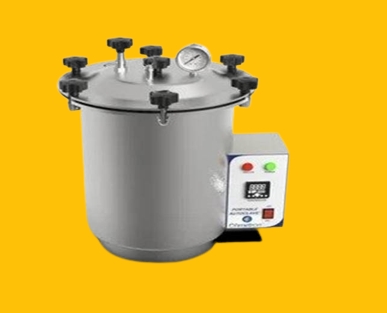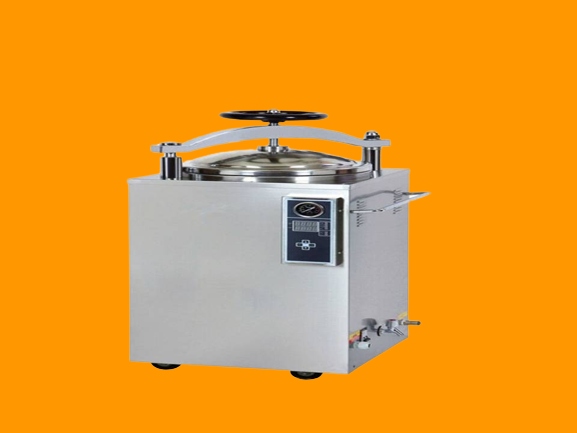Autoclave is also called a steam sterilizer which is used to sterilize the sample by killing bacteria, viruses, and even spores. The material must be put into this equipment vessel and steam under pressure is used for sterilization. It is considered a modern effective method of sterilization and it is based on moist heat sterilization.
Parts of Autoclave
This machine is an important pressure cooker type or laboratory bench autoclave that has the following parts:
a. Pressure Chamber
It is the main part of this apparatus which consists of an inner chamber and an outer jacket. The inner chamber of this apparatus is made of stainless steel or gunmetal. The samples are put in the inner chamber for sterilization. The size of this chamber ranges from 100 L to 3000 L.
b. Lid
It consists of a lid or door which helps to create a sterilized condition inside of the autoclave. It has various parts such as a pressure gauge, pressure releasing unit, and safety valve. The pressure gauge assures the safety of this device and the working condition of the operation because it indicates the pressure created in the autoclave during sterilization. Pressure releasing unit controls the pressure inside the pressure chamber by releasing a certain amount of vapor by lifting itself. The safety valve of the pressure chamber helps to reduce the danger of an explosion.
c. Steam generator
A steam generator or boiler is used to heat the water and generate steam in the inner and the outer chamber which is present underneath the chamber. The water level should have sufficient in the inner chamber for proper heating purposes.
d. Vacuum generator
A vacuum generator is present in this apparatus which drives out the air from the inside of the chamber to create a vacuum inside the chamber. The air pockets inside the chamber help the growth of different microorganisms.
e. Wastewater cooler
Modern autoclave consists of a wastewater cooler to cool the effluent. It helps to prevent any kind of environmental pollution.
Autoclave principle
It works by following the principle of moist heat sterilization. Steam under pressure is used for sterilizing the sample present inside the chamber. High pressure is created by the pressure chamber and boils the water to achieve a higher temperature for sterilization.
The high-pressure steam helps to rapid penetration of heat into deeper parts of the material, and moisture present in the steam helps to coagulate the proteins causing an irreversible loss of function and activity of microbes. The water boils at 121°C at the pressure of 15 psi or 775 mm of Hg in this apparatus. The generated moist steam helps to destroy the microbes in the samples.

Procedure
This device should be checked before beginning to use. Firstly, the chamber of this equipment must be filled with a sufficient amount of water. Saturated steam under at least 15 psi of pressure is used for running at a temperature of 121° C for at least 30 minutes. Then the samples can be placed inside the chamber. The screws of the lid are tightened to ensure an airtight condition, and the electric heater is switched on. They must be adjusted the safety valve to maintain the required pressure in the chamber.
The complete displacement of air is occurred by ensuring the discharge tube lets all the air inside be displaced. Then the pressure of inside steam reaches the desired levels (15 lbs in most cases). The blow of a whistle removes excess pressure from the chamber. This machine should be run for a definite time, which is 15 minutes in most cases after hearing the whistle.
An electric heater is then switched off, and this equipment is allowed to cool for lowering the inside pressure of the atmosphere. Then discharge pipe should be opened for allowing the entry of air from the outside into the autoclave. Then it can be taken out the samples from the autoclave after opening the lid.
Types
There exist various kinds of this equipment which are given below:
Pressure cooker-type
It consists of a metal chamber with a metal lid that can be fastened and sealed with a rubber gasket. It has also an air and steam discharge tap, pressure gauge, and safety valve. An electric immersion heater at the bottom of the chamber can also be found in these autoclaves.
Gravity displacement type
This autoclave is mostly used in various laboratories which have a chamber for sterilization by applying heat. This type of autoclave requires less amount of money to buy than the others.
Positive pressure displacement type
The steam can be generated within seconds by this type of this equipment.
Negative pressure displacement type
This modern autoclave consists of a steam generator as well as a vacuum generator to create good-quality of steam. The produced steam is then passed through this equipment to produce highly sterile samples.
Uses
It is very essential apparatus to sterilize the various materials containing water as they cannot be sterilized by dry heat sterilization. The various laboratory instruments, labware, medical equipment, glassware, surgical equipment, and medical wastes can be sterilized by this apparatus. The various culture media, autoclavable containers, plastic tubes, and pipette tips can be sterilized by helping this apparatus.
Conclusion
This device is very suitable for removing biological hazards by applying heat above boiling point. The medical, pharmaceutical items and laboratory instruments can be sterilized by helping this important instrument. The harmful bacteria, viruses, fungi, and spores can be killed inside the pressure vessel of this apparatus by appropriate heating for a given amount of time.
References
Jain, A., Jain, R., Jain, S., Jain, A., Jain, R., & Jain, S. (2020). Autoclave. Basic Techniques in Biochemistry, Microbiology and Molecular Biology: Principles and Techniques, 9-10.

